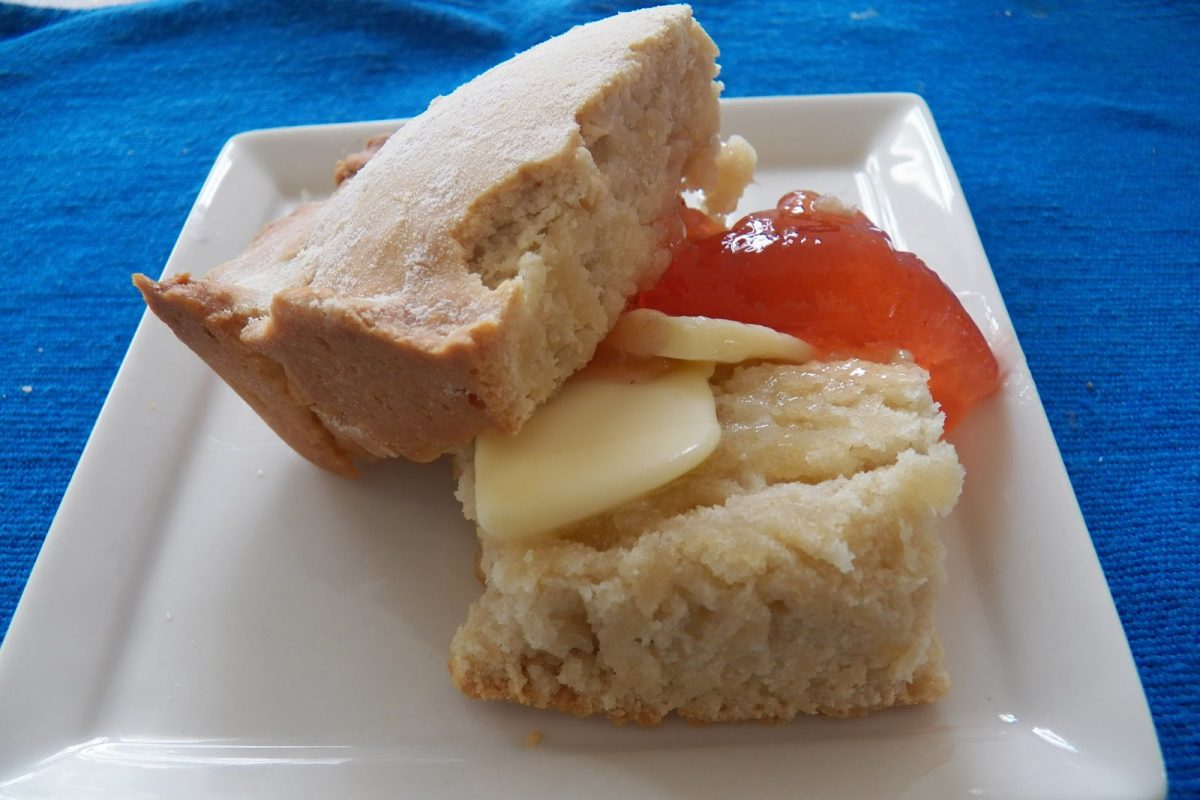Tru Bahamian Must Eat: Guava Jam

Jams and jellies have always been staple items in the pantries of Bahamian households, but one jam reigns supreme in our islands, and that’s Guava Jam! Bahamian Guava Jam is a sweet, pink fruit spread made throughout the entire archipelago where guavas grow profusely. Many locals make Guava Jam themselves, but it’s so popular that when it does show up in grocery stores, the shelves empty within minutes. This decadent spread is very simple yet so versatile that you’ll likely run out of jam before you run out of ideas on how to use it! With so many ways to enjoy Guava Jam, we’ve put together a here’s your how-to guide for making it at home and where to find it in Downtown Nassau’s boutique stores.
What is Guava Jam?

Credit: Tru Bahamian Food Tours
Bahamian Guava Jam is a treat- as many of our past Bites of Nassau Food Tour guests would agree! While guava Jellies are widely available in grocery stores around the world, guava jams are quite hard to find outside countries and islands where guavas grow locally. Considering that jams are much easier to make than jellies because they utilize the majority of the fruit as opposed to only the juice- this tasty spread is even more of a local favourite since we love recipes that take little time to prepare!
Our love for jam here in The Bahamas is likely a predilection passed down from our European ancestors, who developed a taste for jam once sugarcane was introduced to the continent in the 16th Century. Since sugarcane grows throughout The Bahamas, we locals have been making a variety of jams to appease rumbling tummies for as long as we can remember. Jams were also a great way to preserve the abundance of native fruits before spoilage and prolong the shelf-life of some of our favourite flavours.
What’s In Guava Jam?

Credit: Elite Life
Guava Jam is relatively easy to make, but the ingredients do vary depending on your preference. Commonly, Bahamian Guava Jam is made with sugar, pectin or citric acid, and Apple Guavas. Apple Guavas are the most common variety of guava and are native to the Caribbean and Central and South America, so they’ve been here in The Bahamas before even Christopher Columbus’ arrival in 1492! The fruit grows well in our climate and soil, and is rich in vitamin A and C. Though guavas contain a notable number of seeds, the pink flesh is very sweet, so we gladly labour through the seeds to collect the fruit for jam. Some people will use canned guava shells to make Guava Jam as well, but if you can get your hands on a batch of ripe, fresh guavas, the jam will be all the better!
What We Eat With Guava Jam

Credit: Twisted Lime
You see those delectable chicken wings glazed in that thick, juicy, lip-smacking sauce? Those are Barbecue Guava Chicken Wings- just one example of how we creatively use Guava Jam in The Bahamas! Traditionally, Guava Jam is spread on warm, buttery Island Sweet Bread and Johnny Cake as a satisfying breakfast or to accompany an afternoon tea, but it can just as easily be used for other sweet and savory applications.
Here are some of our favourite ways to incorporate Guava Jam into any meal:
- Spread it on toast with peanut butter or dollop it on top of waffles and pancakes
- Add Guava Jam to greek yoghurt and granola for a satisfying parfait
- Drizzle it over desserts for decoration and taste! Or add it to cupcake batter and bake it right in
- Use Guava Jam as a replacement for guava shells when making Bahamian Guava Duff dessert
- Make homemade guava ice cream by adding Guava Jam into the creamy mixture as it churns
- Spread it on a wheel of brie, wrapped in puff pastry, and bake until golden and gooey
- Glaze ribs and chicken wings with a batch of guava-barbecue sauce like they do at Twisted Lime Restaurant & Bar; it’s amazing!
Where To Find Guava Jam In Downtown Nassau

Credit: Alexia Tolas
To be honest, there are not a ton of places to find authentic Bahamian Guava Jam anymore, especially after the closure of Sawyer’s canning factory- formerly one of the largest operations in the country. As a result, most locals make the jam themselves but there are a handful of local businesses, such as V&V Condiments that make large enough batches to sell in local stores throughout the island. While they are few and far between, there are a handful of boutiques that carry Guava Jam in Downtown Nassau, and after inspecting their quality ourselves (many times!), these are the places we recommend grabbing a jar for yourself:
Genuinely Bahamian Boutique
Location: Charlotte and Bay Street
Hours: Mon-Sun, 9:00am-6:00pm
More Info: (242) 356-2242 / Website / Facebook
Pasión Tea & Coffee Company
Location: Festival Place, Prince George Wharf and The Pasión Boutique, Caves Road
Hours: Mon-Sat, 9:00am-9:00pm / Sun, 10:00am-8:00pm
More Info: (242) 327-7011 / Website / Facebook
Graycliff’s Drawbridge Patisserie & Gelateria
Location: West Hill Street, Downtown Nassau
Hours: Mon-Sat, 9:00am-5:00pm
Contact: (242) 302-9190 / Website
How To Make Bahamian Guava Jam

Credit: Tru Bahamian Food Tours
For the hands on DIY chef, Guava Jam is pretty easy to make and requires very few ingredients. If you have a hankering to try concocting our famous Bahamian Guava Jam in your own kitchen, we’ve put together the what and how for this fruity local fave:
Ingredients:
- 2 lbs Apple Guavas (use 2 cans guava shells if fresh fruit is unavailable, see alternative preparation below)
- ⅛ cup Lemon Juice
- Sugar (will vary depending on amount of pulp, see below)
Directions:
Peel the whole guavas to remove all yellow skin. Place guavas in a large pot. Add just enough water to cover the guavas. Boil uncovered until guavas are soft and pulpy. Filter pulp through a sieve to remove all seeds. Measure the pulp, and for every cup of pulp, add ¾-1 cup of sugar. Return pulp and sugar mixture to the pot and cook, stirring constantly. Add lemon juice to thicken the mixture, and continue to stir. Every two minutes, test jam by ladeling a drop of jam onto a saucer. If the jam thickens and gels on the saucer, it is ready. Ladel jam into mason jars and allow to get to room temperature.
Alternatives:
- Use cans of guava shells where fresh fruit is unavailable. Skip the first few steps of softening the guavas to make pulp and instead pulse the contents of the can in a food processor to make a paste of your own.
- If you’re accustomed to using citric acid, replace lemon juice with ½ tsp of powdered citric acid to thicken the jam.
- Also, try adding a pint of fresh mango to the mix to make Guava-Mango Jam!
